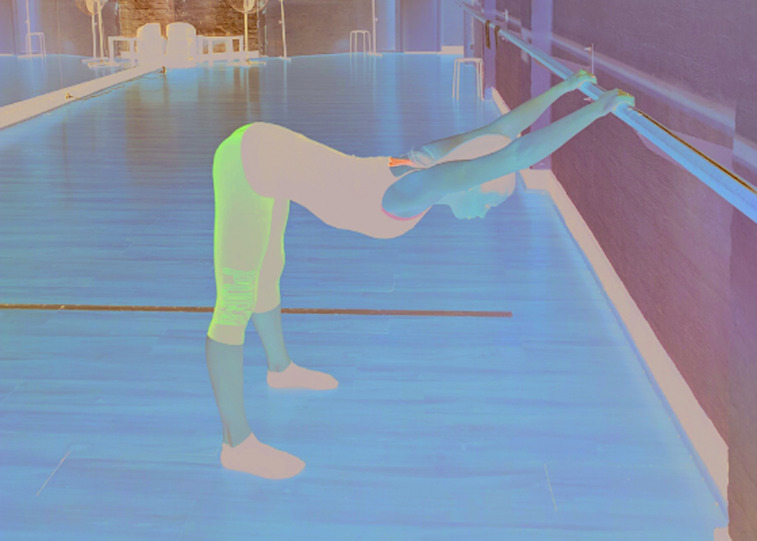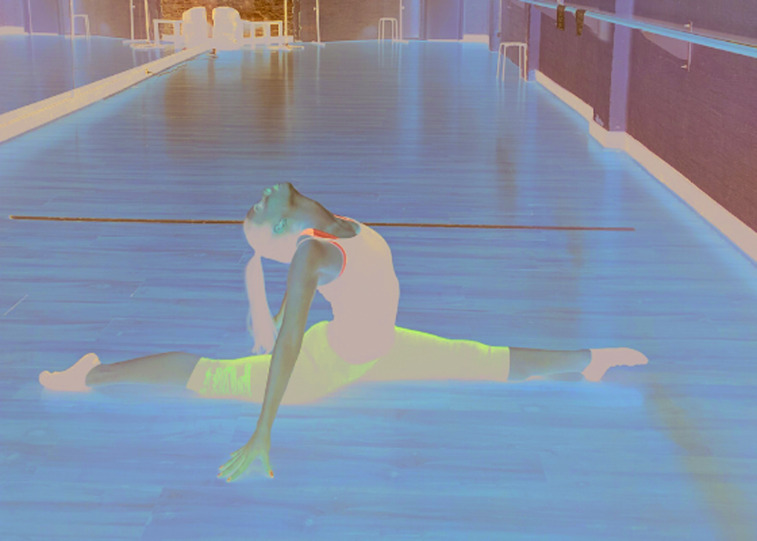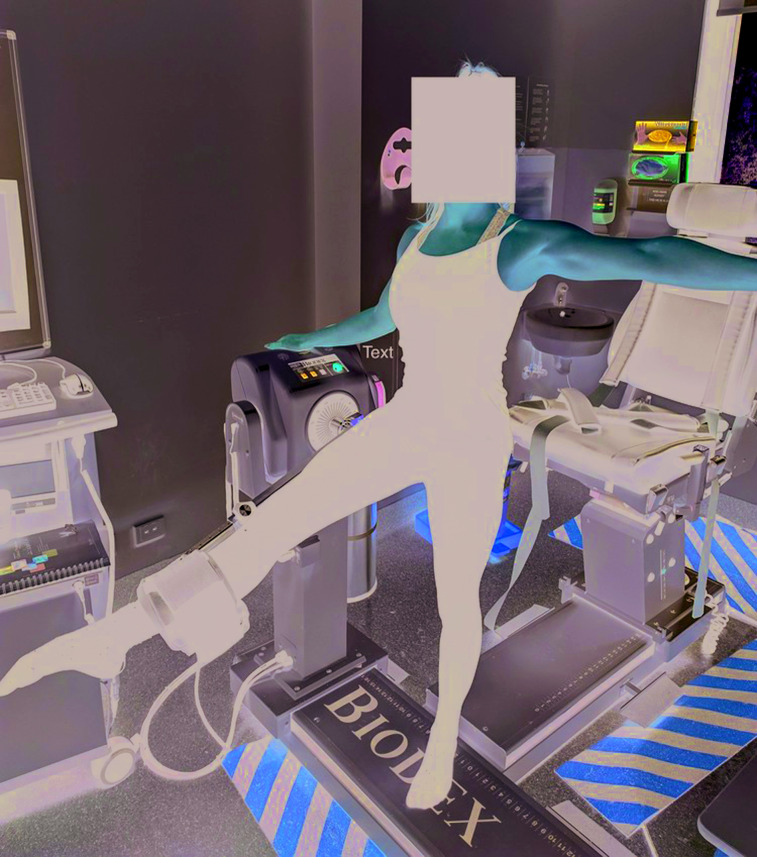Abstract
Background:
There is an increasing cross-fertilization between the movements in contemporary dance and aesthetic sports such as rhythmic gymnastics. In such sports, supplementary training is commonly used to enable athletes to achieve all of their training goals, however dancers typically do not engage in cross training from other disciplines.
Purpose:
The aim of this research was to test the effectiveness of a rhythmic gymnastics-based supplementary training program on lower limb flexibility and power of contemporary dancers.
Study Design:
Experimental study using a between-groups design
Setting:
Training Intervention: Prahran Rhythmic Gymnastics Specialist Centre, Testing: Deakin University
Methods:
Eleven female contemporary dancers were randomly assigned to either a control or intervention group. The intervention group (n = 6) participated in an eight-week rhythmic gymnastics-based supplementary training program comprising two one-hour sessions per week in addition to their usual training. The control group (n = 5) continued their usual dance training. Pre and post measures of range of motion (ROM) and power were taken via a dance-specific kick test using an isokinetic dynamometer and a customized grand jeté test in a 3D-motion laboratory.
Results:
Significant increases in right and left leg grand jeté ROM, right leg peak kicking torque and left leg grand jeté height were recorded in the intervention compared to the control group.
Conclusion:
The results of the study suggest that rhythmic gymnastics training could provide a viable means for contemporary dancers to target active ROM and power of explosive dance movements. Future research should include subjective evaluations of dance performers to confirm that training adaptions are transferred to improvements in performance quality.
Level of Evidence:
III
Keywords: contemporary dance, injury prevention, movement system, rhythmic gymnastics, stretching, supplementary training
INTRODUCTION
The wide variety of technical demands and very limited employment opportunities require that contemporary dancers are physically prepared to perform a diverse repertoire.1,2 To gain a competitive edge in showcasing their skills, contemporary dancers, also referred to as modern dancers, are including more athleticism into their choreography, similar to sports such as rhythmic gymnastics.1,3 In particular, high levels of flexibility and power are required simultaneously to perform the dynamic kicks and leaps increasingly featured in contemporary dance.3,4 It is widely acknowledged that dance only training methods are insufficient to prepare dancers for the physical demands of their discipline, yet dancers typically do not engage in cross training from other sports.5-8
The importance of flexibility to a dancer's facility is demonstrated by beautiful lines and seemingly impossible positions of extreme hip and spine ROM. However, most supplementary training studies in contemporary dance have focused on improving muscular strength, endurance and cardiovascular fitness, rather than active range of motion (ROM) needed for dance movements.3,7,9-15 The lack of focus on improving flexibility in dancers may be due to the common concern that dancers emphasize flexibility while neglecting strength and conditioning.5 However, rhythmic gymnastics training produces athletes with considerably high levels of flexibility and explosive strength suggesting that the development of each fitness variable does not have to be to the detriment of the other.16,17 In addition, attempting extreme ROM in choreography that has not been developed during dance class may pose a risk of injury in dancers.
Combination stretching protocols (dynamic and static) have been shown to be an effective inclusion in contemporary dancers’ warm up as enhanced balance, vertical jump height and hamstring ROM have been reported.18 Wyon et al.14 found that low intensity static stretching, known as microstretching and active strengthening at end ROM were both effective in improving active ROM of a side développé (sideways leg extension) in recreational dancers over six weeks. Vibration training twice per week for four weeks has also been shown to improve dancers’ active ROM of the side développé on both legs, in addition to improvements in parallel countermovement jump height.12 However, more data is required to confirm the effect of long term combination training protocols on dancers’ muscle function.
Muscular power is another component of fitness which has been associated with improved aesthetic qualities of both dance and dancers’ jumping ability.1,9 Dance researchers have suggested that dancers would benefit from dedicated jump training where they could focus on particular aspects such as jump height or take-off and landing mechanics, which they could later re-integrate into their choreography.5,19 Plyometric training is typically used in various sporting populations to improve power and explosive jumping ability.20 Despite this there have been few investigations of plyometric training in dance populations.9 Brown et al.9 found that a traditional plyometric program consisting of four exercises, 96 touches per session, improved both vertical jump height and subjective jump height. The subjective dance evaluation assessed four aspects of the dancers’ aesthetic jumping ability, however, jumps requiring large ROM were not tested.9
Two common power-flexibility movements in both dance and rhythmic gymnastics include the grand battement (large kick) and grand jeté (split leap).19,21,22 The grand battement is a swift and energetic dance kick performed on one leg, usually reaching maximum ROM of the hip joint.23 It can be performed to the front (devant), to the side (à la seconde), and to the back (derriere),23 with the backwards kick also requiring spine extension particularly in the lumbar region. The grand jeté, is a travelling jump which takes off from one leg and showcases splits in the air, before a one-legged landing.19,24 The jump should display height24 and the lead leg should kick quickly into split position so that a 180 degree split line can be showcased before landing. Gymnasts develop these skills by first optimizing the required ROM with dedicated flexibility training.25,26 Following this, they perform daily kicking protocols to optimize explosive kicking strength and lower limb power training including hopping and jumping drills to target aspects of leaping ability including jump height, distance and speed.25,26
The need for dance-specific training interventions and testing is more likely to increase the low acceptance of supplementary training in the dance community.5 In particular, any supplementary training should reflect core-dance movements to increase the likelihood of transfer of learning to dance performance.5 Elite rhythmic gymnastics schools utilize elements of dance training such as ballet to complement their training25 and similarly dancers could potentially benefit from rhythmic gymnastics exercises in their curriculum. Therefore, the aim of this study was to investigate the effectiveness of a rhythmic gymnastics-based power-flexibility program on the lower limb flexibility and power of contemporary dancers.
METHODS
Participants
Eleven intermediate level female contemporary dancers (age 19 ± 2.0 years, height 148 ± 0.03 cm, weight 51.3 ± 3.3 kg, experience in dance training 9 ± 5.3 years, weekly dance training load 12 ± 12.5 hours) volunteered for the study. An a priori power analyses was conducted using effect sizes (Cohen's d)27 calculated from previous publications comparing stretching and strengthening programs on dancers’ ROM and vertical jump height.14,18 To detect the medium effect sizes (Cohen's d = 0.7) calculated from these studies as statistically significant (p < 0.05) with 80% confidence, required 12 participants when using a mixed experimental design comprising two groups (six participants per group) and two time point (pre, post) measurements for each group (G*Power, Version 3.1.9.4, Germany). Participants were randomly allocated to either the control or intervention group and were screened with a pre-activity survey to determine their training history and practices and ensure they were free from injury, not pregnant and not currently undertaking any form of gymnastics power-flexibility training prior to participating in the study (Appendix A). Ethical approval was obtained from the Deakin University Human Research Ethics Committee and all participants provided informed consent prior to commencing the study (Ethics number: 210-110).
Training Protocol
The training program was derived and delivered face to face by the lead author drawing upon a decade-long experience in rhythmic gymnastics and national coaching accreditation. Details of the training program are presented in Table 1, Figures 1-5 and Appendix B.
Table 1.
Training Program Outline: Example of a Typical Training Session.
| Activity* | Duration/Volume# |
|---|---|
| Flexibility Training Component x 2/wk | |
| General Warm Up | |
| Skipping/Running | 5 mins (continuous) |
|
Standing Stretches at Barre: 1. Static calf stretch 2. One Leg on Barre: a) lunge front foot on barre b) hamstring stretch 3. Moving between 2a & 2b 4. Shoulder stretch to barre (Figure 1) |
Total: 5 mins 10 s x 2 e/l 10 s e/l 10 s e/l Reps: 8 e/l 30 s |
|
Floor Body Preparation: PNF partner stretching: 1. Butterfly (feet together, knees out) 3 positions: a) sitting b) lying c) sitting reaching forward 2. Stretching knees 3. Pike stretches: a) bent knees, straight back b) straight knees, flexed feet c) straight knees, pointed toes 4. Pike pulses 5. Lunges a) back leg straight, arms on floor b) arms to side c) back heel to bottom d) side lunge 6. Spine extension roll throughs 7. Straddle: a) chest to leg b) side stretch c) forward stretch 8. Straddle side leans 9. Straddle adductor strengthening 10. V- Sit abdominal strengthening: (single, single, double leg- 1 rep) 11. Frog with arch 12. V-sit addominal strenthening: (single, signle, double leg- 1 rep) 13. Proline double quad stretch (heels to bottom) 14. Cradle spine extension lift 15. Floor splits: a) straight split b) back leg bend c) split w arch (Figure 2) 16. Proline arabesque kicks: a) chest lifted b) rocking forward (Figures 3 & 4) 17. Push through middle splits & return |
Total: 20 mins 10 s resist, 10 s relax x 2 sets x 10 s e/l x 10 s each Reps: 8 x 10 s each e/l Reps: 4 x 10 s each e/l Reps: 8 Reps: 8 Reps: 8 x 10 s Reps: 8 x 10 s each e/l Reps: 8 each Reps: 8 |
|
Supersplits (from box): 1. Right leg forward elevated 2. Left leg forward elevated 3. Left shin back elevated 4. Right shin back elevated 5. Middle split: a) Right leg elevated b) Left leg elevated |
Total: 10 mins 2 mins 2 mins 2 mins 2 mins 1 min 1 ;min |
|
Back Extensions 1. Kneeling arches 2. Assisted back raises |
Reps: 8 Reps: 8 |
| Example Plyometric Session x 1/wk | |
| Warm Up Jumping Protocol | |
| 1. Runs: knees to chest/heels to bottom 2. Vertical jumps/tuck jumps 3. Forward chasses right 4. Forward chasses left 5. Alternating single leg double tuck hops 5. Alternating stag leaps 7. Alternating cossack hops |
5 mins 1 row/gymnastics mat length per exercise |
| Main Plyometric Session | |
| 1. Continuous double leg box jumps Box Height: 450mm Progression: a) wks 1-4: 1 box up & down b) wks 5-8: 3 consecutive boxes |
80 foot contacts Reps: 10 Sets: 2 Rest between sets: 60 s Reps: 10 Sets: 1 |
| 1. Travelling kicks to jetés Progression: a) wks 1&2: no resistance b) wks 3&4: 0.5 kg leg weights c) wks 5-8: more advanced exercises |
24 foot contacts Reps: 3 kicks- 3 Jetes Sets: 2 each leg Rest between sets: 30 s |
| 1. Alternating split leap Progression: a) wks 1 & 2- no resistance b) wks 3&4- 0.5 kg leg weights c) wks 5-8: more advanced exercises |
16 foot contacts Reps: 4 Sets: 2 Rest between sets: 30 s |
| Total contacts/session = 120 | |
| OR Dance kicking protocol at barre x 1/wk | |
| Each exercise performed right leg (6 reps) then left leg 1. Forward 2. Side 3. Arabesque 4. Ponchee 5. Ring (foot to head) 6. Side w lean 7. Forward kick w back extension Progression Wks 1/2: no therabands Wks 3/4: set 1 theraband, set 2 without Wks 5/6: both sets therabands Wks 7/8: therabands shortened to increase resistance |
Reps: 6 each Sets: 2 Time under tension: 80 s Rest between sets: 6 mins |
| Cool Down | |
| 1. Wall pike static stretch 2. Right gluteals static stretch 3. Left gluteals static stretch 4. Spine roll downs |
5 mins (inc transitions) x 1 min x 1 min x 1 min x 1 min |
*Refer to Appendix B for full details and figures of each exercise, #Static stretches list stretch durations, dynamic stretches and conditioning exercises list repetitions, PNF = proprioceptive neuromuscular facilitation, wk(s) = week(s), w = with, e/l = each leg, s = seconds, min = minute, reps: repetitions
Figure 1.
Shoulder stretch to bar.
Figure 5.
Kneeling arches.
Figure 2.
Split with arch.
Figure 3.
Proline arabesque kicks: chest lifted.
Figure 4.
Proline arabesque kicks: rocking forward.
Frequency: In consideration with the following recommendations and a dancers usual training schedule which already includes some stretching and jumping, two sessions per week was decided an appropriate volume for the intervention. Guidelines for flexibility training typically recommend a frequency of two to three days per week with most benefit gained from daily exercise.28 (Figures 1-5) For plyometric training the frequency of sessions is often dictated by appropriate recovery times which is typically considered between 48 and 72 hours between sessions.29 Recommended foot contacts per session range from 80-100 for beginners to 120-140 for advanced athletes.30 Since the dancers were experienced in jumping but not specifically in plyometric training, a moderate level of 120 foot contacts were programmed for the main plyometric session for the first four weeks. This was reduced to 100 foot contacts for the final four weeks as exercise intensity increased.
Intensity: Intensity of the main plyometric program was increased with 0.5kg ankle weights being added for some of the exercises, during weeks three and four and weeks seven and eight. In week five there was also an increase in the difficulty of the jumping drills that was continued for the last four weeks. A moderate level of Thera-Band resistance (green) was used to gradually increase the intensity of the dance kicking protocol from weeks three to eight. Once foot loops had been tied, the length of band spanned from the floor to the dancers mid-thigh. The Thera-Bands were added for one set of kicks in weeks three and four, both sets of kicks in weeks five and six and then the bands were shortened with an extra wrap around the standing foot for increased resistance for the final two weeks. Thera-Band resistance is a preferred method of resistance training in dance as its flexibility allows the specific muscle actions performed in dance choreography at optimal speed, plane and direction.31 Stretch intensities were not prescribed and were moderated by the dancers.
Time: Each training session was one hour in duration, progressively increasing in difficulty in terms of movements performed and ROM of exercises. The general warm up lasted ten minutes consisting of five minutes of continuous running or skipping and five minutes of basic stretching to prepare the body for the main component of the program. A 20-minute specific warm up included a combination stretching protocol of dynamic stretches, strengthening exercises and short duration (10 seconds) static stretches to keep the body active whilst also preparing the body for the advanced flexibility exercises to come. For the same reasons, proprioceptive neuromuscular facilitation (PNF) stretch durations were kept to 10 seconds resist, 10 seconds relax which is similar to that used by Rubini et al. 32 to improve adductor flexibility in ballet dancers. These methods are consistent with recommendations for appropriate warm ups.33 The dynamic stretches and strengthening exercises were typically eight repetitions per exercise making them easy for a dance teacher to adapt them to music later on if desired. Advanced flexibility exercises such as supersplits stretching were prescribed at two minutes per exercise as this is typical in rhythmic gymnastics training to achieve long term improvements in lower limb flexibility and in particular split lines.34,35
Type: The training intervention was based on the Victorian Rhythmic Gymnastics High Performance Centre Senior Elite Training Syllabus.35 Both sessions each week involved the general warm up, combination stretching protocol (specific warm up) and advanced flexibility exercises including supersplits and back extensions. This was followed by either the dance kicking protocol, one session per week or the plyometric jumping protocol for the other session per week, and cool down. Combination stretching protocols programmed in sequences which require body control and muscle strength are typical in rhythmic gymnastics training.25,26 The periodized plyometric jumping program incorporated some traditional plyometric exercises such as variations of box jumps, as well as specific drills to target the grand jeté (split leap).19 Using a combination of plyometric jumping exercises is recommended for optimal enhancement.36 The control group were asked not to undertake any new forms of supplementary training during the research period.
Power and Flexibility Assessments
To obtain measures of lower limb power, hip flexor peak torque was measured during dance kicks performed in an isokinetic dynamometer (Biodex System 4 Pro, Biodex Medical Systems, Shirley, USA). All participants performed two sets of five consecutive standing forward kicks with straight legs and correct upright posture. Two minutes rest in between sets was used for sufficient recovery.37 The height of the dynamometer was aligned with the participant's greater trochanter while the kicking leg was strapped to the end of the dynamometer attachment just below the gastrocnemius so a straight leg would be maintained (Figure 6). This was a unique set up that allowed dancers to kick with a straight leg as they would in a grand battement (large kick) in dance choreography. The speed of the dynamometer was set to 300 degrees per second to ensure the speed was not limiting the dancer's movement. All data from the dynamometer was sampled at 100 Hz.
Figure 6.
Biodex testing set up: peak torque of a dance kick.
To obtain measures of dance-specific jumping performance, participants performed two sets of three grand jetés with two minutes rest in between sets for recovery of energy. This form of jump has been previously used to analyze jumping performance in aesthetic sports and is frequently programmed dance choreography in a sequence of three.19,22,24,38,39 All jumps were performed in the Deakin MotionLab. Participants’ peak jump height, lead leg velocity and lower limb flexibility were measured using a 24-camera, high speed motion analysis system (Eagle 4, Motion Analysis Corporation, Santa Rosa, USA) sampling at 120 Hz. Retro-reflective markers were placed bilaterally on participants’ lateral malleolus, lateral tibial condyles and greater trochanters. Singular markers were also placed on each participants’ fifth lumbar vertebrae (L5) and the mid-sternum. A set of familiarization jumps were performed before data collection to allow the participants to become accustomed to the equipment and testing protocol. Both the intervention and control group were tested one week before the commencement of the training program and were re-tested one week after the completion of the eight-week training.
Data Analysis
Peak torque values for the dance kicks performed in the dynamometer were exported to Microsoft Excel 2007 (Microsoft Corp. USA). In isokinetic testing the first two repetitions are often less reproducible than subsequent repetitions,37 therefore, values from kicks three to five from the second set of kicks were averaged and used to determine peak kicking power of each participant. Motion data from both sets of three grand jetés were processed using Cortex (Motion Analysis Corporation, Santa Rosa, USA) to form ‘stick’ figures. All data was smoothed at 5 Hz using a fourth order, dual pass Butterworth digital filter. The smoothed data allowed the maximum ROM, ankle velocity and height during each grand jeté to be measured. The maximum ROM of the leg split in the grand jeté was obtained from an angle subtended from the L5 marker to each of the lateral knee markers at the peak of each jump. Maximum jump height was obtained from the peak vertical displacement of the sternum marker. Maximum ankle velocity was calculated based on peak velocity of the lead leg ankle marker in each grand jeté. All data was then exported from Cortex into Microsoft Excel.
Statistics
Statistical analysis was performed on all data using SPSS (IBM Corp, New York, NY). This included examining the percentage changes from pre to post intervention for both groups on all outcome measures. Shapiro-Wilk tests of normality conducted on the participant's characteristics and the performance measures pre- and post-intervention revealed all variables were normally distributed. A Mann-Whitney U test was performed at the beginning of the intervention period to assess the equivalence of the two groups in terms of age, weight, height, training hours per week and years training in dance. A two-way repeated measures analysis of variance (ANOVA) was used to assess changes in flexibility and power between the intervention and control groups after the intervention period. Statistical significance was set at p < 0.05.
RESULTS
Eleven participants completed this study (6 intervention, 5 control). Mann-Whitney U test revealed no difference between the intervention and control groups for age (p = 0.28), weight (p = 0.29), height (p = 0.67), training hours per week (p = 0.21) and years training in dance (p = 0.68). Further, tests for normality showed participants’ characteristics as well as all performance variables measured pre and post intervention for both groups of participants were normally distributed. When the post-intervention performance variables were compared to their corresponding pre-intervention levels, a significant improvement was observed for right and left grand jeté ROM, right leg peak kicking torque and left leg grand jeté height for the intervention group compared to the control group. These results are presented in bilateral form for each performance variable, mean group results are presented in Table 2.
Table 2.
Mean Group Results.
| Right | Left | ||||
|---|---|---|---|---|---|
| Group | Variable | Pre | Post | Pre | Post |
| Intervention | Peak Kicking Torque (nM) | 50.7 ± 7.81 | 64.6 ± 7.22* | 50.8 ± 2.87 | 61.1 ± 9.13 |
| Grand Jeté ROM (°) | 109.3 ± 22.71 | 114.3 ± 15.99* | 106.9 ± 21.62 | 111.6 ± 14.69* | |
| Grand Jeté Height (m) | 0.2 ± 0.03 | 0.3 ± 0.06 | 0.2 ± 0.01 | 0.3 ± 0.07* | |
| Grand Jeté Lead Leg Velocity (m/s) | 3.4 ± 0.95 | 4.2 ± 0.90 | 3.6 ± 0.54 | 3.7 ± 0.30 | |
| Control | Peak Kicking Torque (nM) | 64.8 ± 16.68 | 62.6 ± 10.70* | 62.0 ± 17.05 | 65.1 ± 9.45 |
| Grand Jeté ROM (°) | 123.0 ± 17.13 | 112.9 ± 17.65* | 119.8 ± 17.19 | 112.3 ± 18.69* | |
| Grand Jeté Height (m) | 0.2 ± 0.04 | 0.2 ± 0.04 | 0.2 ± 0.04 | 0.2 ± 0.03* | |
| Grand Jeté Lead Leg Velocity (m/s) | 3.7 ± 0.70 | 3.7 ± 0.55 | 3.8 ± 1.06 | 3.7 ± 0.89 | |
* Significant change pre to post intervention between groups (p<0.05)
Right leg peak kicking torque increased by 27.5 ± 26.0% in the intervention group compared to a 3.4 ± 12.1% decrease in the control group post-intervention (p = 0.028). Although left leg peak kicking torque increased by 20.2 ± 22.3% pre to post-intervention, when compared to the 5.0 ± 28.7% increase observed in the control group post-intervention, this change was not different between groups (p = 0.363).
Right grand jeté ROM increased by 4.5 ± 10.3% in the intervention group pre to post-intervention, compared to the 8.2 ± 4.8% decrease observed in the control group post-intervention (p = 0.011). Left grand jeté ROM also increased in the intervention group pre to post-intervention by 4.4 ± 12.7%, compared to a 6.3 ± 3.8% decrease seen in the control group post-intervention (p = 0.035).
When grand jetés were performed with the right leg leading, peak height increased by 37.1 ± 30.5% in the intervention group compared to a 6.7 ± 23.5% decrease in the control group post-intervention. While there was a trend for improvement on the right side, these changes were not significant (p = 0.063). Conversely, when grand jetés were performed with the left leg leading, jump height increased by 50.9 ± 44.3% in the intervention group compared to a 9.4 ± 21.8% decrease observed in the control group post-intervention and this difference pre to post-intervention between groups was significant (p = 0.033).
Grand jeté lead leg velocity with the right lead leg increased by 23.1 ± 38.8% in the intervention group compared to a 1.1 ± 6.1% decrease in the control group post-intervention (Figure 10). Lead leg velocity with the left lead leg increased by 3.1 ± 12.7% compared to the 1.2 ± 10.6% decrease observed in the control group post-intervention. These changes were however not different between groups on either the right (p = 0.115) or left (p = 0.532) leg.
DISCUSSION
The aim of this study was to investigate the effectiveness of a rhythmic gymnastics-based power-flexibility program on the lower limb flexibility and power of contemporary dancers. The main findings from this study found that the rhythmic gymnastics-based supplementary training program in addition to a contemporary dancer's usual dance training schedule, improved bilateral lower limb ROM and improved right leg peak kicking torque and left leg grand jeté height.
In this study, the training intervention successfully improved grand jeté ROM which was not seen in the group who performed dance training alone. This finding extends prior research that has demonstrated the positive effects of targeted flexibility training on muscle compliance and ROM in dancers.14,18,40 However, the effectiveness of the rhythmic gymnastics-based power-flexibility program is a novel contribution. Jump height is a key variable contributing to aesthetically pleasing performances in dance.1,9 Improvements in jump height following plyometric training are well-documented in the literature.41 In the current study the intervention group significantly increased their left grand jeté height in comparison to the control group, with a trend towards improvement on the right side after only eight weeks of training. These results are in agreement with Brown et al.9 who found vertical jump height improved in dancers after a relatively short period of plyometric training, six weeks. Brown et al.9 also used a subjective measure of jumping ability and found that plyometric training also improved ratings of perceived jump height but not overall jumping ability. This could reflect the traditional nature of the plyometric program used, which unlike the current study, did not include dance style movements or jumps. While aesthetic jumping ability was not specifically assessed in the current study, the parameters were tested in dance movements, so it is reasonable to hypothesize that there may be greater transference to dance-specific aesthetic assessments. Future research should assess the impact of a similar training regimen on subjective ratings of dance performance.
From the current training intervention there were marked differences in changes in grand jeté height between limbs with a 14% greater increase in height for left leg grand jeté. Changes in peak kicking torque post-intervention were also not consistent. Right leg peak torque increased by 7.7% in the intervention group pre to post training whereas there were no significant interactions with left leg torque. The notion that there may be a differential response to training between limbs is not a new phenomenon.42 It has been suggested that novel skills or exercises are often learned first on one side and then transferred to the other and in dance this is common practice.42 Wyon et al.19 proposed an additional suggestion that dancers may use different strategies to produce jumping power on dominant vs non-dominant sides. The majority of participants in the intervention group were right leg dominant and this is the take-off leg in the left grand jeté. The reactive strength of the take-off leg is typically the greatest determinant of vertical jump height for single leg run up jumps 43 as is the grand jeté. Additionally, training protocols lasting 10 weeks or longer have demonstrated greatest training benefits from plyometric exercises.41 Therefore, extending the intervention program to 12 weeks may have allowed more time for the development of power on the dancers’ non-dominant side.
The lateral preference for tasks requiring ROM on the right side and balance and stability on the left is the most commonly mentioned in the literature.42 It appears the commonly dominant right ROM- left balance pairing may have responded more quickly than the alternative side to the training and/or testing protocol. While this study attempted to use a novel dance-specific test to assess peak torque, the participants were still constrained to some degree as their leg was strapped to the dynamometer attachment. While all other aspects of the kick technique and posture were kept as realistic as possible, the effect of this constraint on torque production is unknown.
The fourth performance measure, grand jeté lead leg velocity did not change in either group pre to post intervention. However, a self-paced approach was used for the grand jeté training and performance test which may have not led to dancers reaching maximum velocity during the testing. Secondly, pace of dance movements is typically dictated by the music44 and there was no music used in testing or during the training intervention. These factors should be considered in future analysis of supplementary training for contemporary dance.
The current study veered away from traditional approaches of fitness training and instead created a novel supplementary training program from the aesthetic sport considered most similar to dance, rhythmic gymnastics. This is a significant step forward for the dance conditioning literature and provides a platform for research and practice in dance-specific supplementary training. There is also a scarcity of literature describing three-dimensional (3D) kinematic analysis of common dance movements.23 Most assessments of flexibility in dancers have been made via goniometer measures, photography and (2D) video analysis1,14,18,40 all of which have limited reliability and applicability. To the authors knowledge, the current study is the first to assess ROM in grand jetés using 3D motion analysis and peak torque of a dance kick using isokinetic dynamometry. This study also adds to the small group of literature reporting right-left data for dancers performing specific dance skills.19,24,42
Limitations
The current study has some limitations, firstly, the study was slightly underpowered with one less participant in the control group than required from the a priori power analysis. Recruiting participants for the study was challenging since the dancers already had significant training commitments. Some dancers also seemed reluctant to try a new form of training, potentially because the dance environment typically doesn't advocate supplementary training.8 Regarding training procedures, dancers were allowed to self-regulate their own stretch intensities due to their familiarity with stretching and this could have varied between dancers. It is not possible to narrow down exactly which exercises from the intervention are most effective in improving the ROM and power of contemporary dancers, although it is likely the combination of rhythmic gymnastics-based training is more effective than one exercise alone. Finally, this study population included all female contemporary dancers and it is not known whether the results are generalizable to other dance styles or male dance populations.
Future Research
As presented, the current study has created a platform for future research using rhythmic-gymnastics inspired supplementary training to condition dancers. Future research should combine the testing protocols used in the current study with a reliable and validated aesthetic competence dance tool to see how the improvements in specific fitness components translate into actual dance performance. Extending the training protocol to 12 weeks, prescribing a set pace to the dance kicks and leaps and monitoring the dancers stretching intensity may influence performance outcomes. Including both male and female dancers from multiple dance specialities such as contemporary and classical dance, would also assess the generalizability of a rhythmic gymnastics supplementary training program for use in the wider dance population. Finally, a rhythmic gymnastics-based training program could have scope to improve flexibility and power in other sports which warrants further investigation.
Conclusion & Practical Application
This study demonstrated that an eight-week rhythmic gymnastics-based supplementary training program improved the lower limb flexibility and power of contemporary dancers. This was evidenced by improvements in the performance of dance jumps such as the grand jeté as well as isokinetic torque during a dance kick. Due to its specificity to dance, the supplementary training intervention used in this study has the potential to be easily incorporated into a dance training schedule as it requires little traditional gym equipment and can be performed in a dance studio environment. Therefore, incorporation of this program would not only have the potential to improve the flexibility and power of contemporary dancers but may potentially also improve their overall performance and increase their likelihood of attaining work in this highly competitive occupational environment.
Appendix A
Pre-Activity Survey
The following questionnaire is designed to establish a background of your medical history and identifies any injury and/ or illness that may influence your testing and performance. Please answer all questions as accurately as possible and if you are unsure about anything, please ask for clarification. All information provided is strictly confidential.
Personal Details
Name:________________________________
Date of Birth (D/M/Y):__________________
Height: _________________ m
Weight: _________________kg
Medical History
Have you ever had, or do you currently have any of the following?
If Yes, please provide details
Do you have or have you had any hip, back or lower limb pain in the last 6 months?
Y N
___________________________________________________________________
Have you recently injured your hips, back or lower limbs?
Y N
___________________________________________________________________
Is there any other condition or injury not previously mentioned which may affect
your participation in this study?
Y N
___________________________________________________________________
Are you pregnant?
Y N
___________________________________________________________________
Training Habits
For how many years have you been involved in Dance Training?
___________________________________________________________________
How many days & hours per week are you involved in Dance Training? Where do you currently train?_______________________________________________________
What styles of dance do participate in?
___________________________________________________________________
Are you involved in any supplementary fitness training or any form of gymnastics training, please elaborate?
Y N
___________________________________________________________________
Declaration
I acknowledge that the information provided on this form, is to the best of my knowledge, a true and accurate indication of my current state of health.
Signature:____________________________ Date:_______________
APPENDIX B: Detailed Exercise Description
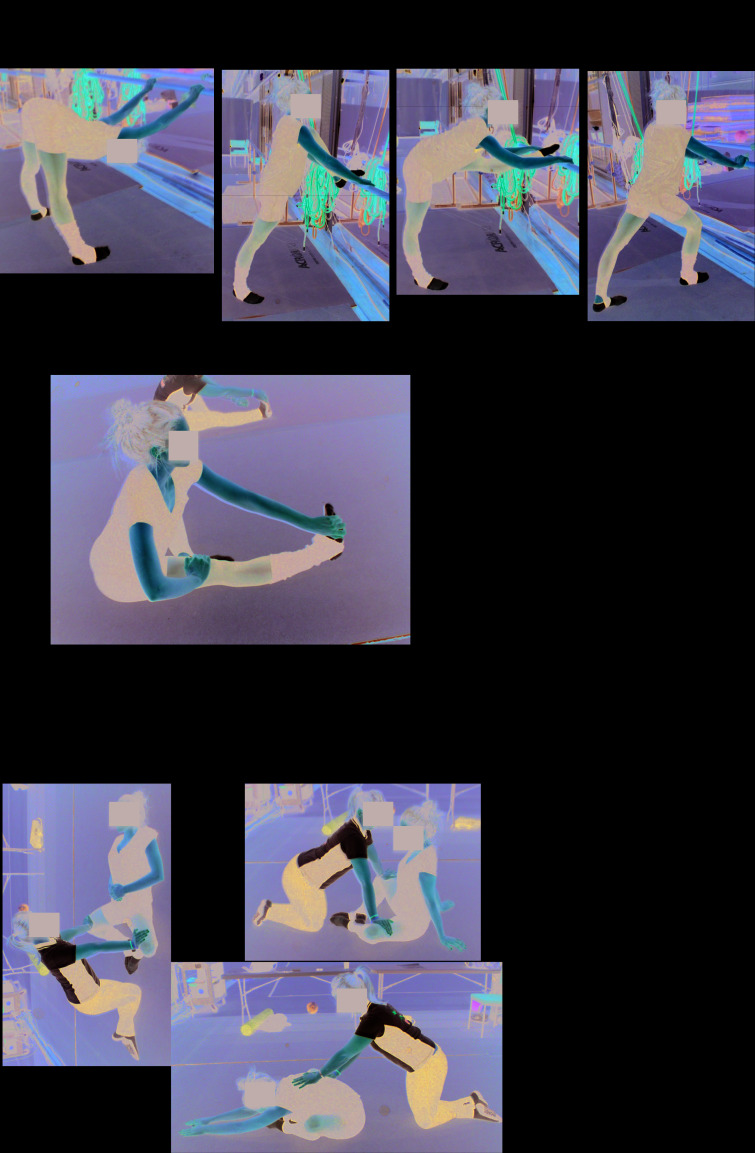
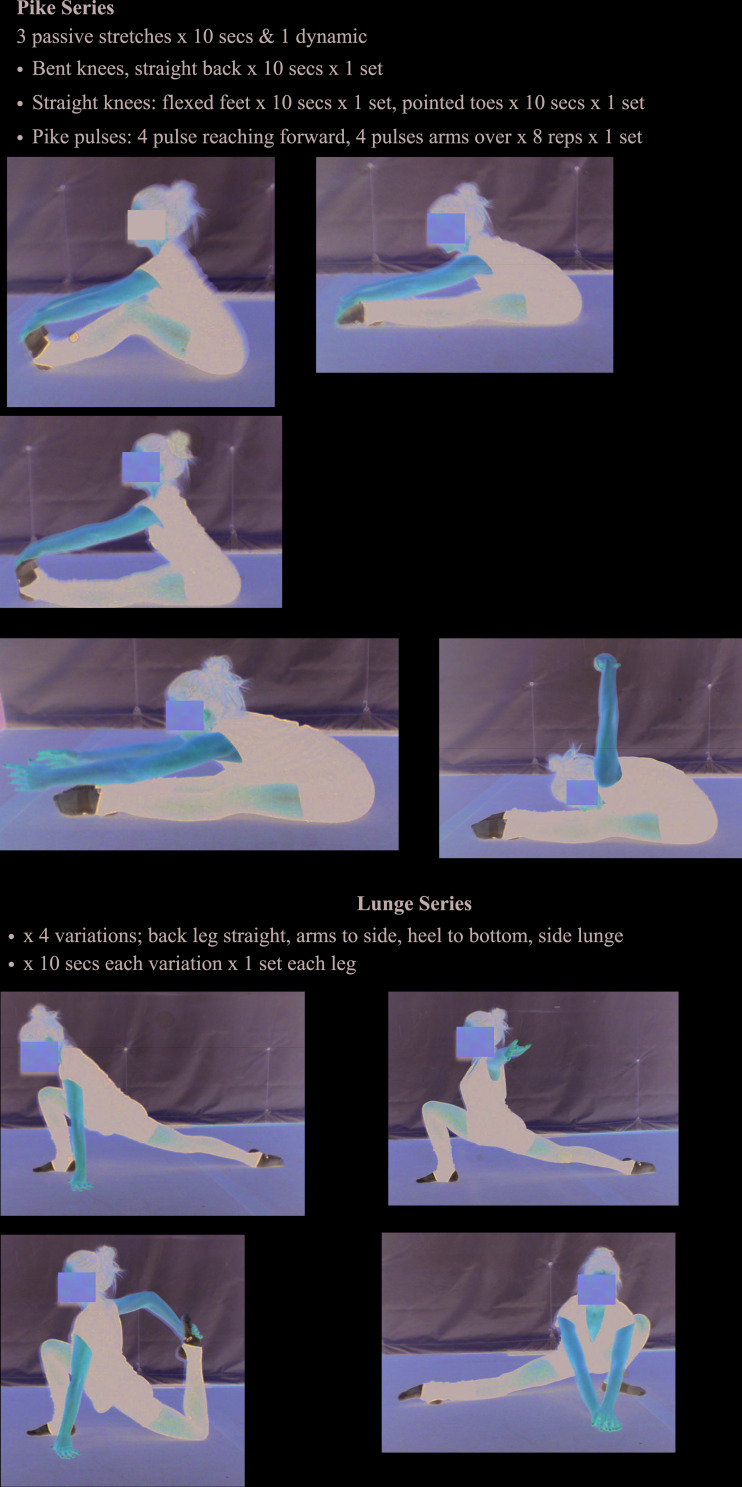
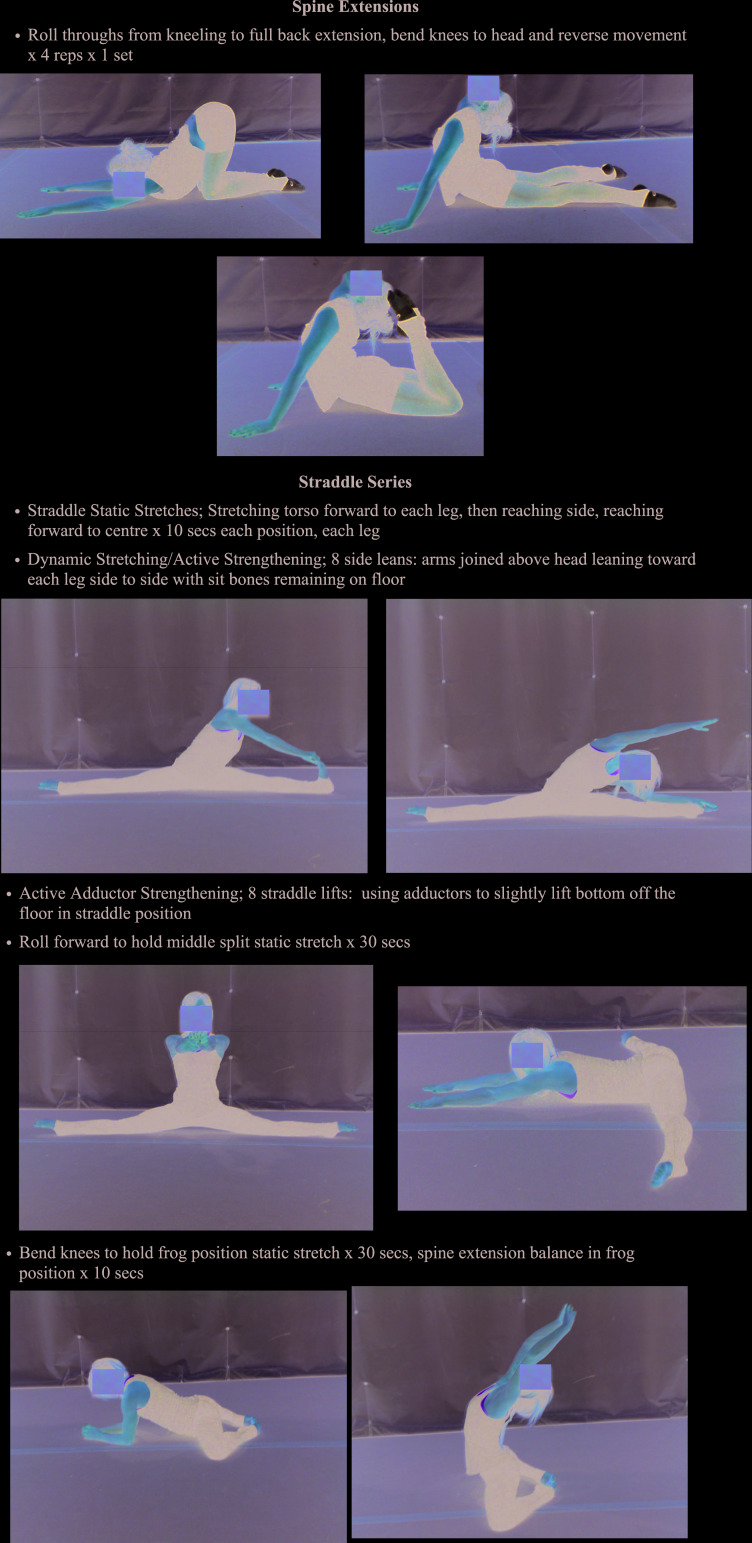
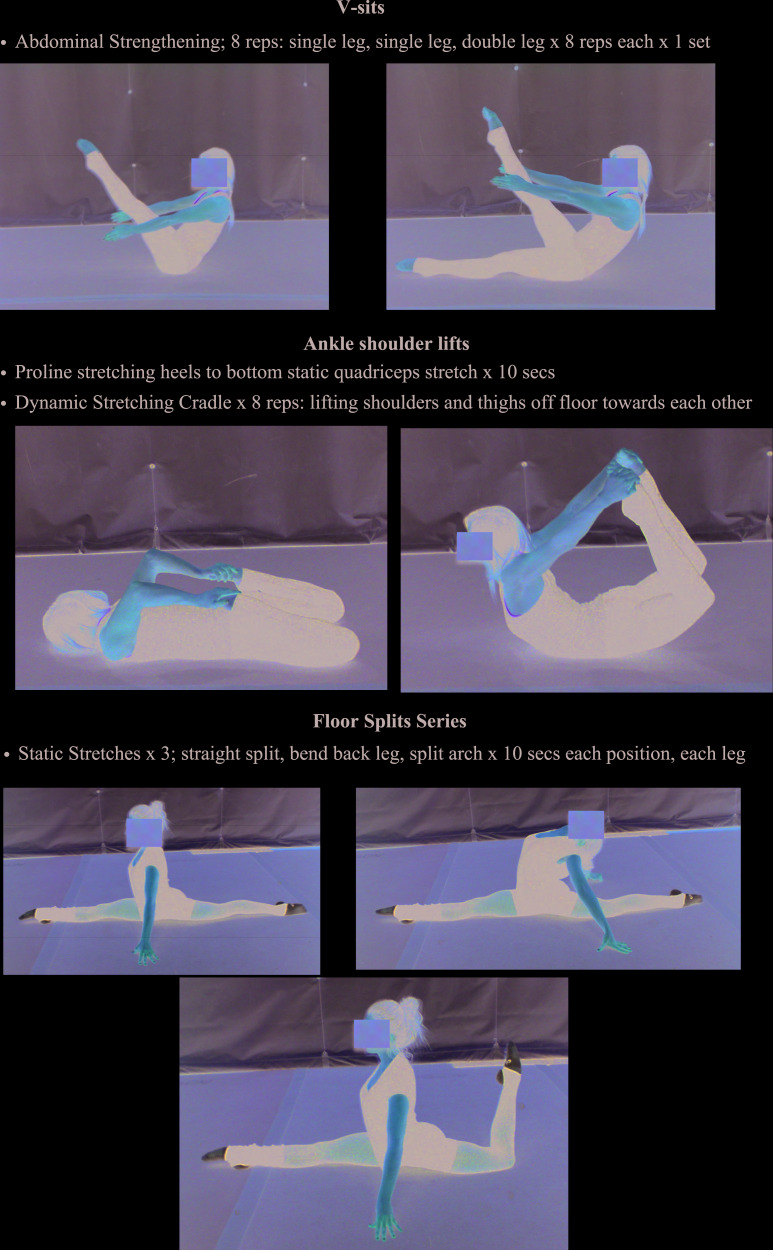
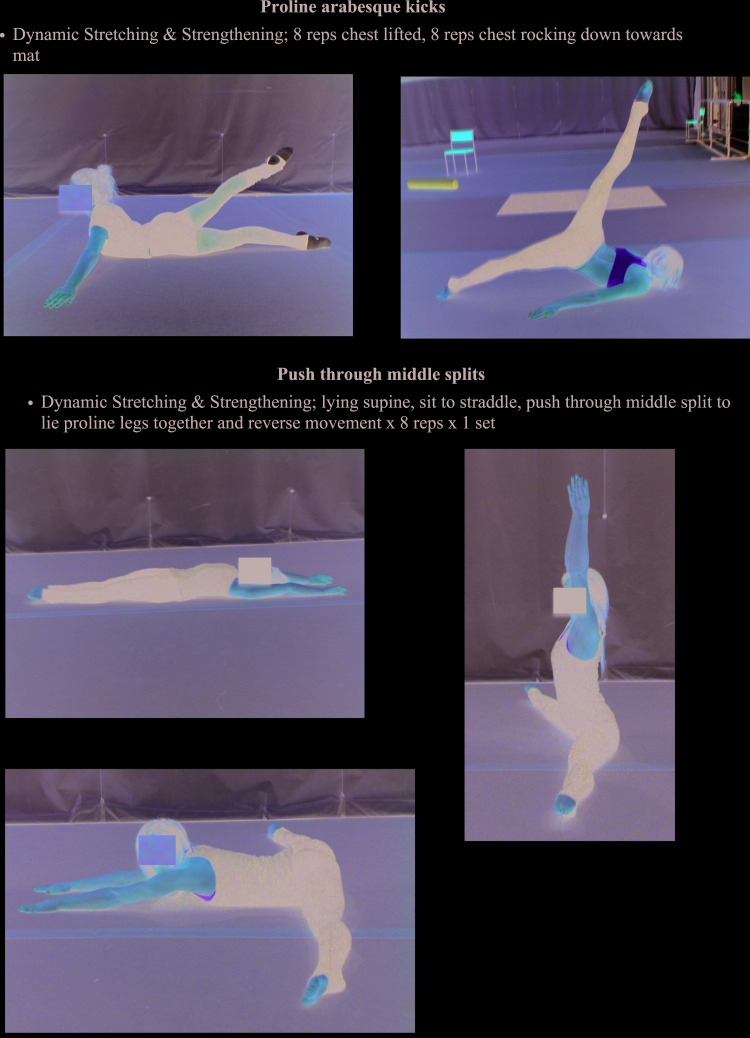
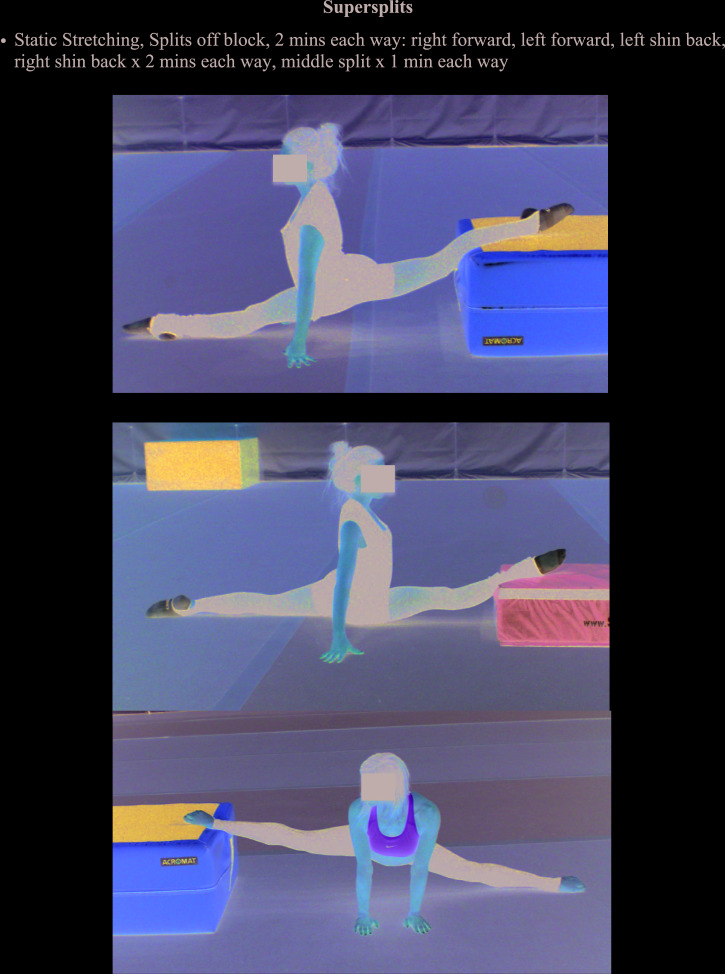
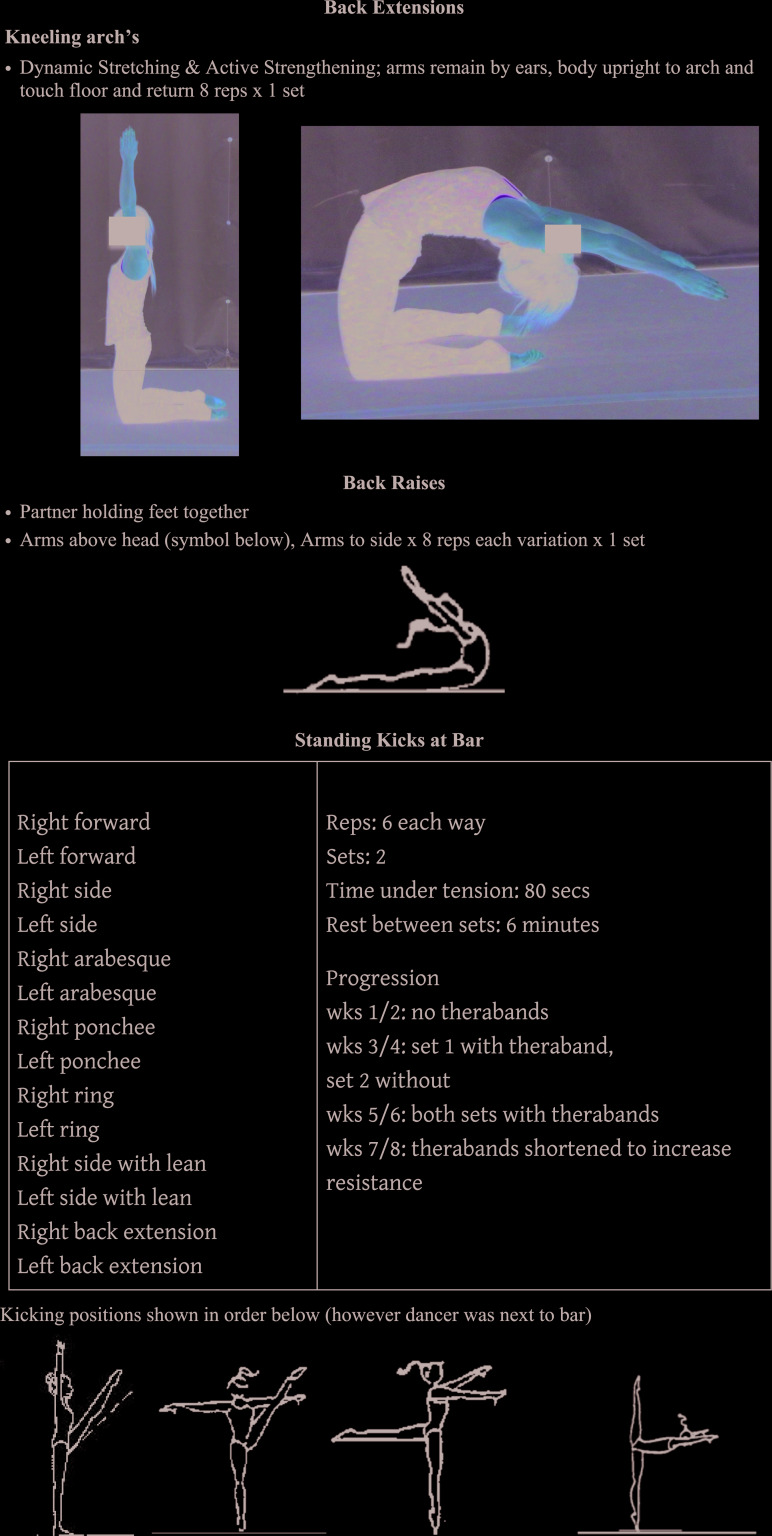


REFERENCES
- 1.Angioi M Metsios GS Twitchett E Koutedakis Y Wyon M Association between selected physical fitness parameters and aesthetic competence in contemporary dancers J Dance Med Sci 2009134115-123 [PubMed] [Google Scholar]
- 2.Bennett D. Careers in dance: Beyond performance to the real world of work. J Dance Educ. 2009;9(1):27-34. [Google Scholar]
- 3.Angioi M Metsios G Koutedakis Y Wyon MA. Fitness in contemporary dance: a systematic review. Int J Sports Med. 2009;30(07):475-484. [DOI] [PubMed] [Google Scholar]
- 4.Deighan MA. Flexibility in dance. J Dance Med Sci. 2005;9(1):13-17. [Google Scholar]
- 5.Rafferty S. Considerations for Integrating Fitness into Dance Training. J Dance Med Sci. 2010;14(2):45-49. [PubMed] [Google Scholar]
- 6.Twitchett E Wyon M Angioi M Koutedakis Y. Do increases in fitness affect aesthetics aspects of ballet performance. In:2013.
- 7.Rodrigues-Krause J Krause M Reischak-Oliveira Á. Cardiorespiratory Considerations in Dance From Classes to Performances. J Dance Med Sci. 2015;19(3):91-102. [DOI] [PubMed] [Google Scholar]
- 8.Wyon M. Testing an aesthetic athlete: contemporary dance and classical ballet dancers. In: Winter EM Jones AM Davison RR Bromley PD Mercer TH eds. Sport and exercise physiology testing guidelines. Vol 2. United Kingdom: Routledge; 2006:249-262. [Google Scholar]
- 9.Brown AC Wells TJ Schade ML Smith DL Fehling PC. Effects of plyometric training versus traditional weight training on strength, power, and aesthetic jumping ability in female collegiate dancers. J Dance Med Sci. 2007;11(2):38-44. [Google Scholar]
- 10.Koutedakis Y Hukam H Metsios G, et al. The effects of three months of aerobic and strength training on selected performance-and fitness-related parameters in modern dance students. J Strength Cond Res. 2007;21(3):808-812. [DOI] [PubMed] [Google Scholar]
- 11.Angioi M Metsios G Twitchett EA Koutedakis Y Wyon M. Effects of Supplemental Training on Fitness and Aesthetic-Competence Parameters in Contemporary Dance: A Randomised Controlled Trial. Med Probl Perform Art. 2012;27(1):3-8. [PubMed] [Google Scholar]
- 12.Marshall LC Wyon MA. The effect of whole-body vibration on jump height and active range of movement in female dancers. J Strength Cond Res. 2012;26(3):789-793. [DOI] [PubMed] [Google Scholar]
- 13.Malkogeorgos A Zaggelidou E Zaggelidis G Christos G. Physiological elements required by dancers. Sport Sci Rev. 2013;22(5-6):343-368. [Google Scholar]
- 14.Wyon MA Smith A Koutedakis Y. A Comparison of Strength and Stretch Interventions on Active and Passive Ranges of Movement in Dancers: A Randomized Controlled Trial. J Strength Cond Res. 2013;27(11):3053-3059. [DOI] [PubMed] [Google Scholar]
- 15.Roussel NA Vissers D Kuppens K, et al. Effect of a physical conditioning versus health promotion intervention in dancers: a randomized controlled trial. Man Ther. 2014;19(6):562-568. [DOI] [PubMed] [Google Scholar]
- 16.Miletic´ Đ Katic´ R Maleš B. Some anthropologic factors of performance in rhythmic gymnastics novices. Coll Antropol. 2004;28(2):727-737. [PubMed] [Google Scholar]
- 17.Douda H Avloniti A Kasabalis A Tokmakodis SP. Adaptations on Physical Performance Characteristics after a 6-Month Specific Training in Rhythmic Gymnasts. Med Probl Perform Art. 2007;22(1):10-17. [Google Scholar]
- 18.Morrin N Redding E. Acute effects of warm-up stretch protocols on balance, vertical jump height, and range of motion in dancers. J Dance Med Sci. 2013;17(1):34-40. [DOI] [PubMed] [Google Scholar]
- 19.Wyon M Harris J Brown D. Bilateral differences in peak force, power, and maximum plié depth during multiple grande jetés. Med Probl Perform Art. 2013;28(1):28-32. [PubMed] [Google Scholar]
- 20.Booth MA Orr R. Effects of plyometric training on sports performance. STRENGTH COND J. 2016;38(1):30-37. [Google Scholar]
- 21.Krasnow D. An investigation of grand battement devant at barre, centre, and in motion using kinematics and electromyography. In: University of Wolverhampton; 2012. [Google Scholar]
- 22.Cicchella A. Kinematics analysis of selected rhytmic gymnastic leaps. 2009.
- 23.Bronner S Ojofeitimi S. Pelvis and hip three-dimensional kinematics in grand battement movements. J Dance Med Sci. 2011;15(1):23-30. [PubMed] [Google Scholar]
- 24.Golomer E Féry Y-A. Unilateral jump behavior in young professional female ballet dancers. Int J Neurosci. 2001;110(1-2):1-7. [DOI] [PubMed] [Google Scholar]
- 25.Batista A Gomes TN Garganta R Ávila-Carvalho L. Training intenisty of group in rhythmic gymnastics. Ovidius Univ Ann Ser Phys Educ Sport Sci Mov Health. 2018;18(1):17-24. [Google Scholar]
- 26.Guidetti L Di Cagno A #Gallotta MC Battaglia C Piazza M Baldari C. Precompetition warm-up in elite and subelite rhythmic gymnastics. J Strength Cond Res. 2009;23(6):1877-1882. [DOI] [PubMed] [Google Scholar]
- 27.Cohen J. A power primer. Psychol Bull. 1992;112(1):155-159. [DOI] [PubMed] [Google Scholar]
- 28.Garber CE Blissmer B Deschenes MR et al. American College of Sports Medicine position stand. Quantity and quality of exercise for developing and maintaining cardiorespiratory, musculoskeletal, and neuromotor fitness in apparently healthy adults: guidance for prescribing exercise. Med Sci Sports Exerc. 2011;43(7):1334-1359. [DOI] [PubMed] [Google Scholar]
- 29.Sole CJ. Plyometric Training. In: Turner, AC P, ed. Advanced Strength and Conditioning : An Evidence-Based Approach. . Milton: Routledge; 2017:274-290.
- 30.Potach D Chu D. Program design and technique for plyometric training. Essentials of Strength Training and Conditioning. 2016:471-520. [Google Scholar]
- 31.Franklin E. Conditioning for Dance. Champaign, IL: Human Kinetics; 2004. [Google Scholar]
- 32.Rubini EC Souza AC Mello ML Bacurau RFP Cabral LF Farinatti PTV. Immediate Effect of Static and Proprioceptive Neuromuscular Facilitation Stretching on Hip Adductor Flexibility in Female Ballet Dancers. J Dance Med Sci. 2011;15(4):177-181. [PubMed] [Google Scholar]
- 33.Behm DG. The Science and Physiology of Flexibility and Stretching : Implications and Applications in Sport Performance and Health. Milton, UK: Routledge; 2018. [Google Scholar]
- 34.Donti O Tsolakis C Bogdanis GC. Effects of Baseline Levels of Flexibility and Vertical Jump Ability on Performance Following Different Volumes of Static Stretching and Potentiating Exercises in Elite Gymnasts. J Sports Sci Med. 2014;13(1):105-113. [PMC free article] [PubMed] [Google Scholar]
- 35.Centre VRGHP. Senior elite training syllabus. In. Victoria, Australia: Gymnastics Victoria; 2006.
- 36.de Villarreal ES-S Kellis E Kraemer WJ Izquierdo M. Determining variables of plyometric training for improving vertical jump height performance: a meta-analysis. J Strength Cond Res. 2009;23(2):495-506. [DOI] [PubMed] [Google Scholar]
- 37.Lenaerts A Verbruggen L Duquet W. Reproducibility and reliability of measurements using a linear isokinetic dynamometer, Aristokin. J Sports Med Phys Fit. 2001;41(3):362. [PubMed] [Google Scholar]
- 38.Hutchinson MR Tremain L Christiansen J Beitzel J. Improving leaping ability in elite rhythmic gymnasts. Med Sci Sports Exerc. 1998;30:1543-1547. [DOI] [PubMed] [Google Scholar]
- 39.Di Cagno A #Baldari C Battaglia C, et al. Factors influencing performance of competitive and amateur rhythmic gymnastics—Gender differences. J Sci Med Sport. 2009;12(3):411-416. [DOI] [PubMed] [Google Scholar]
- 40.Wyon M Felton L Galloway S. A Comparison of Two Stretching Modalities on Lower-Limb Range of Motion Measurements in Recreational Dancers. J Strength Cond Res. 2009;23(7):2144-2148. [DOI] [PubMed] [Google Scholar]
- 41.Stojanovic´ E Ristic´ V #McMaster DT, Milanovic´ Z. Effect of plyometric training on vertical jump performance in female athletes: a systematic review and meta-analysis. Sports Med. 2017;47(5):975-986. [DOI] [PubMed] [Google Scholar]
- 42.Kimmerle M. Lateral bias, functional asymmetry, dance training and dance injuries. J Dance Med Sci. 2010;14(2):58-66. [PubMed] [Google Scholar]
- 43.Ham DJ Knez WL Young WB. A deterministic model of the vertical jump: implications for training. J Strength Cond Res. 2007;21(3):967. [DOI] [PubMed] [Google Scholar]
- 44.Stevens CJ Kroos C Halovic S, et al. Analysis of contemporary dance movement in the presence and absence of a musical soundscape. Paper presented at: Proceedings of the 3rd triennial International Conference of the Asia-Pacific Society for the Cognitive Sciences of Music: APSCOM3, which is held as a joint meeting with 10th International Conference on Music Perception and Cognition (ICMPC), held in Sapporo, Japan, 25-29 August, 2009.



